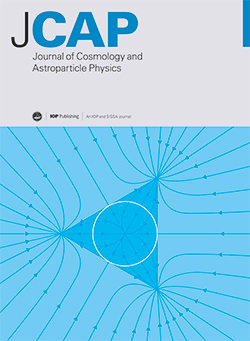Imprints of black hole charge on the precessing jet nozzle of M87*
IF 5.3
2区 物理与天体物理
Q1 ASTRONOMY & ASTROPHYSICS
Journal of Cosmology and Astroparticle Physics
Pub Date : 2025-02-26
DOI:10.1088/1475-7516/2025/02/065
引用次数: 0
Abstract
The observed jet precession period of approximately 11 years for M87* strongly suggests the presence of a supermassive rotating black hole with a tilted accretion disk at the center of the galaxy. By modeling the motion of the tilted accretion disk particle with the spherical orbits around a Kerr-Newman black hole, we study the effect of charge on the observation of the precession period, thereby exploring the potential of this strong-gravity observation in constraining multiple black hole parameters. First, using the Hamiltonian formalism, we derive the equations of motion for spherical orbits, along with the general forms of energy and angular momentum, in the general stationary axisymmetric black hole spacetime. Subsequently, taking the Kerr-Newman black hole as a specific example, we study the effect of charge on spherical orbits and find that the precession period increases with increasing charge. Furthermore, incorporating the constraints of EHT on the black hole charge, we utilize the observed M87* jet precession period to constrain the relationship between the spin, charge, and warp radius, specifically detailing the correlations between each pair of these three quantities. To further refine constraints on the charge, we explore the negative correlation between the maximum warp radius and charge. A significant result shows that the gap between the maximum warp radius of the prograde and retrograde disk decrease with the black hole charge. If the warp radius is provided by other observations, different constraints on the charge can be derived for the prograde and retrograde cases. Finally, we investigate the size of the inner disk. By making use of current observations, our study reveals that the size of the inner disk increases with the charge and spin, and the prograde disk is always larger than the retrograde one. These results provide significant effects of charge in the physics around M87*.求助全文
约1分钟内获得全文
求助全文
来源期刊

Journal of Cosmology and Astroparticle Physics
地学天文-天文与天体物理
CiteScore
10.20
自引率
23.40%
发文量
632
审稿时长
1 months
期刊介绍:
Journal of Cosmology and Astroparticle Physics (JCAP) encompasses theoretical, observational and experimental areas as well as computation and simulation. The journal covers the latest developments in the theory of all fundamental interactions and their cosmological implications (e.g. M-theory and cosmology, brane cosmology). JCAP''s coverage also includes topics such as formation, dynamics and clustering of galaxies, pre-galactic star formation, x-ray astronomy, radio astronomy, gravitational lensing, active galactic nuclei, intergalactic and interstellar matter.
 求助内容:
求助内容: 应助结果提醒方式:
应助结果提醒方式:


